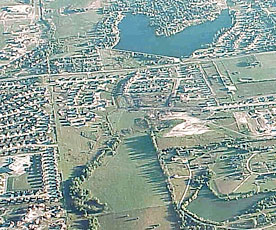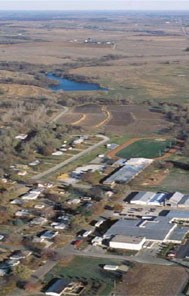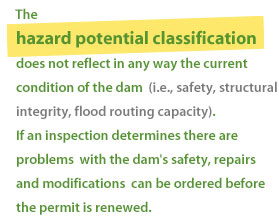About EAPs
What is a High-Hazard Potential Dam?
Each state has definitions and methods to determine the Hazard Potential of a dam. The Hazard Potential is defined as a situation which creates the potential for consequences such as loss of life, property damage, or other adverse impacts.
 Neighborhood association dams in suburban communities can be a significant risk to downstream residents and their homes, workers and their businesses, and even those who may be merely passing through the area.
Neighborhood association dams in suburban communities can be a significant risk to downstream residents and their homes, workers and their businesses, and even those who may be merely passing through the area.
Extensive development downstream from dams in rural areas will increase the risk to lives and property in the event of a dam failure.
These adverse impacts may occur in a defined area downstream of a dam because of flood-waters released through spillways and outlet works of the dam or because of waters released by partial or complete failure of the dam. Adverse impacts also may occur upstream of the dam from effects of backwater flooding or landslides around the reservoir perimeter.
Texas has the highest number of state-regulated dams in the United States – more than 7,130. In Texas, a dam is regulated by the Dam Safety Program of the Texas Commission on Environmental Quality (TCEQ) if the dam is (1) 25 feet or higher, with a maximum impounding capacity of 15 acre-feet, or (2) 6 feet or more high and can impound 50 acre-feet or more. Categories of exception include highway and railroad embankments, levees, and certain impoundments away from stream channels. The height of a dam is measured from the effective crest of the dam to the lowest point on the downstream toe. (See this website’s glossary for further terms and definitions.)
Dam Safety Program engineers determine the "hazard potential" of a dam, meaning the probable damage that would occur if the structure failed, in terms of loss of human life and economic loss or environmental damage. Dams are assigned one of three classes based on the nature of their hazard potential:
- Low-Hazard Potential (LHP). No loss of human life expected (no permanent habitable structures in the breach inundation area downstream of the dam); and minimal economic loss (located primarily in rural areas where failure may damage occasional farm buildings, limited agricultural improvements, and minor highways).
- Significant-Hazard Potential (SHP). Loss of
human life possible (one to six lives or one or two habitable
structures in the breach inundation area downstream of the dam);
or appreciable economic loss, located primarily in rural areas
where failure may cause:
- damage to isolated homes;
- damage to secondary highways;
- damage to minor railroads; or
- interruption of service or use of public utilities, including the design purpose of the utility
- High-Hazard Potential (HHP).
Loss of human life expected (seven or more lives or three
or more habitable structures in the breach inundation area downstream
of the dam); or excessive economic loss, located primarily in or
near urban areas where failure would be expected to cause extensive
damage to:
- public facilities;
- agricultural, industrial, or commercial facilities;
- public utilities, including the design purpose of the utility;
- main highways; or
- railroads used as a major transportation system.
- public facilities;
The Federal Emergency Management Agency (FEMA) and federal agencies that build and manage dams classify as HHP any dam where human life is at risk. Since the SHP classification in Texas includes the possibility of lost human lives, a more accurate count of HHP dams in Texas must include SHP dams. Combined the total of these dams in Texas was 1,773 as of 2013. The total changes upward annually as (1) new HHP or SHP dams are built, (2) LHP dams are reclassified because of downstream development, and (3) the Dam Safety Program becomes aware of dams that have not been counted in its inventory. Often it is only when a dam has an emergency that the Dam Safety Program becomes aware it exists.
The classification of dams can be changed if the hazard potential has changed. When dams are spaced so that the failure of an upper dam would likely cause failure of a lower dam (“cascading”), the consequence of the lower dam's failure determines the upper dam's hazard classification.
Inspections, Exemptions, Laws and Regulations
All state-regulated HHP and non-exempt SHP dams are inspected at least once every five years. The state's dam safety staff has been expanded significantly in recent years with the goal of keeping all of these dams inspected on schedule. More than 200 SHP dams have been exempted from further routine inspection and EAP requirements due to recent changes in Texas dam safety law. By definition of their classification, these dams remain a potential threat to human life.
 Not all dams 6 feet or more in height fall under state regulation
in Texas. Like most states, Texas does not regulate dams constructed,
licensed and maintained by U.S. government (U.S. Army Corps of Engineers,
Federal Energy Regulatory Commission, Department of the Interior
Bureau of Reclamation). Also exempt are dams designed, built and
inspected by the federal Mine Safety and Health Administration or
the U.S. Department of Agriculture’s Natural Resources Conservation
Service (NRCS).
Not all dams 6 feet or more in height fall under state regulation
in Texas. Like most states, Texas does not regulate dams constructed,
licensed and maintained by U.S. government (U.S. Army Corps of Engineers,
Federal Energy Regulatory Commission, Department of the Interior
Bureau of Reclamation). Also exempt are dams designed, built and
inspected by the federal Mine Safety and Health Administration or
the U.S. Department of Agriculture’s Natural Resources Conservation
Service (NRCS).
The fact that a dam does not fall within the inspection jurisdiction of the Dam Safety Program does not mean it is safe. Texas dam safety regulators note that many of the state’s unregulated, private dams have gone unchecked for decades. Dams that don't get regular inspections can erode over the years, or be damaged by floods. Some of these potentially hazardous dams are several miles from a downstream city that would be threatened by a failure.
State dam regulations are found in the Texas Administrative Code, Title 30, Part 1, Chapter 299. Portions pertaining specifically to EAPs are in Rule 299.61.
